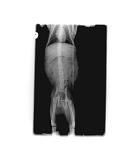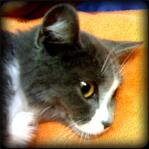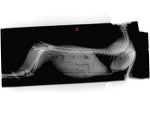How to Tell If Your Kitten Is In Pain

The hip joint on the left shows the pelvic fracture
6-Month Old Kitten Versus Automobile= Fractured Pelvis
Sugar is a 6-month-old grey and white short, plush haired cat. She usually stayed indoors all the time, but when repairman came tho the house, she slipped out the door. Her family looked for hours, but she was nowhere to be found.
3 days later, she crawled up to the porch, her hind legs dragging, a pained, awful, desperate look on her face. Still, mom and dad did not rush to the emergency room. They gave her food, water, and a warm, comfortable bed, and waited until the next day to come see Doc Truli. They could find no sores, no wounds, they really couldn’t tell what had happened to Sugar.
“Why didn’t they take the kitten right to the vet’s office,” you ask.
I was wondering the same thing.
Sugar’s mom explained, “I thought she must be in pain, but she didn’t cry or meow or anything. So I thought maybe I was wrong and she’d be okay. I didn’t want to stress her with the car ride.” (Veterinarians hear this almost every day.)
Doc Truli had the benefit of x-rays, that showed fractures in many places in Sugar’s pelvis.
But there were clear signs that Sugar was in a great deal of pain.
Signs of Pain in a Kitten or Cat:
1. Look at the kitten’s face.
Look at this picture and ask yourself, “Is this kitten happy or sad?”
Sad, right?
Notice the unfocused, distracted, almost inward stare slightly to her side and to the back. She is thinking about the pain in her hips and back.
Don’t worry, I took this picture as I was giving her a good painkiller injection.
2. Watch the breathing.
Sugar was calm, and then she started breathing faster with the ribs visibly moving up and down with the effort. A cat in pain takes great effort to breath. Normally, you should not notice any increased respiratory effort.
3. Watch the body language. (We saw this before with the hunched back kitty.)
In this case, look at the hind legs. This kitten is not relaxed in the animal hospital, she is barely moving at all. The hind legs are extended and positioned in a wholly unnatural pose, especially for being in a stressful, unfamiliar environment.
This position is because of pain in the hind end, and a reduced ability to move.
4. Illogical purring and “kitten bread-making” indicate self-comforting, coping, trying to cope with pain.
Many, many people say,” But I thought purring meant the cat was happy.” Same goes for the kneading with the front paws, reminiscent of the kneading a neonate performs at the nipple in order to simulate mother’s milk to flow.
Sometimes the Doc thinks maybe people aren’t as smart as the kittens. All meaning is contextual. If you see a kitten purring in an extremely stressful situation, or after 3 days of no food, after dragging herself up the porch to let her family know she needs help, this purring is a coping mechanism, like a person rocking themselves to sleep the first night in a strange new place.
Always, always assume there is pain if you have any suspicion there might be pain. “I didn’t know” is a poor excuse, at best.
Always, always assume there is pain if you have any suspicion there might be pain. And always assume there is pain if you have knowledge that something occurred that you or a reasonable person would find painful. Like a gunshot wound, or auto trauma, or dog attack. You may think this advice is obvious, but every day veterinarians run into people who either didn’t think it through or perhaps believe “I didn’t know” is an adequate excuse.







Nice post
I have always thought that purring is as much a cause as an effect – that, inasmuch as a cat can think, the cat is thinking, “When I’m happy, I purr – therefore, if I purr, I’ll become happy.” It always surprises me to realize how many long-time cat owners don’t “get” this. (I wouldn’t be too surprised by non-cat-owners not twigging to this, but how do you have a cat, or multiple cats, for years, and not recognize when something’s wrong?) Thanks for a great post – I’ll be bookmarking it for future reference.